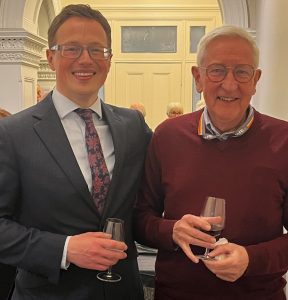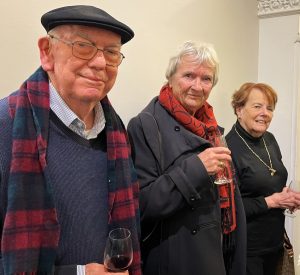
by Helen Randerson, from Bulletin 5 of 2024, July
On Wednesday 29 May, an informative and entertaining lecture entitled ‘Regenerative Cities and Flourishing Communities: why more trees might mean less loneliness and better health’ was given at Benledi by Professor Thomas Astell-Burt from the Cities and Planetary Health group in the University of Sydney’s School of Architecture. Prof. Astell-Burt shared his knowledge and enthusiasm for the importance of nature and well-designed green space for improving the health of the world’s city-dwellers.
Professor Astell-Burt was delivering the Glebe Society’s 8th Annual Biodiversity Lecture to a Glebe audience of nature buffs that values its precious hard-won green space and who were all wanting to find out more. The event was funded by generous donations to the Blue Wren Subcommittee by Norma Hawkins, Mary Holt and Chris Newton.
We discovered that an enormous amount of world-wide scientific research has already established what most of us know intuitively – that there are a range of health benefits, physical, psychological and social – from getting out into nature and away from our digital devices. These health benefits include reduction in blood pressure, cardiovascular disease and diabetes, reduced loneliness, better sleep, less dementia and better ‘social fitness’. A walk or any physical activity in a natural environment is better than a work-out in a gym or pilates studio. Despite this, one in three Australian adults spends less than two hours per week in any natural environment.
Planning better-designed urban green space that addresses utility, functionality, aesthetics – and diversity in vegetation – will need to accompany increases in urban density for the health of humanity and future generations. A Vienna research study has demonstrated that the amount of per capita green space matters greatly and this will need to be monitored in Sydney’s planning to ensure that future ‘density is done well’.
We learned that Canada has introduced ‘nature prescriptions’ where a doctor can prescribe a referral to, for example, a community garden or a ‘park run’ as part of a patient’s individual health plan. Canada also provides free passes to its National Parks as part of a patient’s treatment plan. Research has shown that ‘nature prescriptions’ should address motivations and barriers for them to be effective, equitable and sustainable. If ‘nature prescriptions’ are to be effective, a person’s motivation, whether autonomous or controlled, will need to be explored to maximise health benefits – guilt and social pressure may be less effective motivations than if the ‘nature prescription’ is viewed as fun or more aligned with a person’s goals and values.
Professor Astell-Burt interspersed his lecture with graphics of assorted parks and green space which showed a variety of good designs and natural features. These included a pool and seascape at Maroubra, the tranquil riverside Davidson Park Forestville, arched tree vegetation at Rowe Street Eastwood, the Chinese Gardens and Darling Square at Darling Harbour, a ‘greened’ footpath at Belmont Street Alexandria, Shepherd Lane in Darlington and Supertree Grove in Singapore. An unidentified park with just a large expanse of grass and one log was given a big ‘thumbs down’ – there needs to be something in a well-designed park or green space that’s worth stopping for.

Before questions, Professor Astell-Burt touched briefly on the notion of ‘solastalgia’ – the feeling that occurs following destructive changes in our territory, whether as a result of human activities or the climate.
There followed a range of audience questions covering the many challenges we face including: promoting biodiversity in our cities; the importance of layers and density in vegetation for our green spaces; how to build better for increased urban population density; the health challenges of urban apartment living; the small amount of green space available per capita; the need for better consultation and leadership including the desire for our institutions to lead with more creative ideas that will enhance biodiversity; and the quality of our urban green spaces while at the same time improving human health. Further questions and discussion from the audience occurred as we had a glass of wine and some Japanese finger food.








There are no comments yet. Please leave yours.